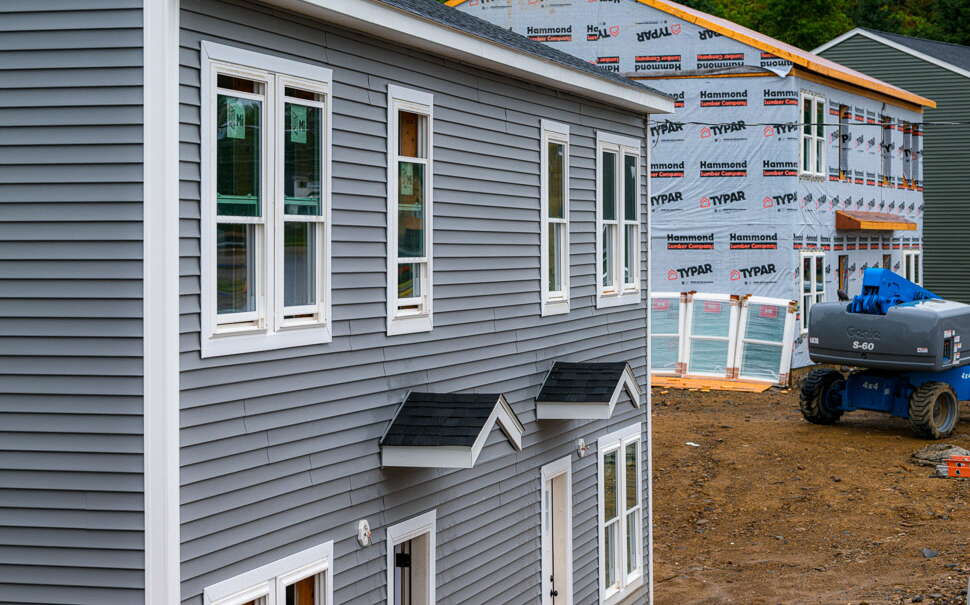
Processing Your Payment
Please do not leave this page until complete. This can take a few moments.
Building homes in Bangor: Developers, local officials tackle Queen City’s housing gap
About 2 miles north of downtown Bangor near the Essex Woods, a new neighborhood is emerging on 12 acres that stood vacant for years.
Despite a delayed start and other hurdles, duplexes are going up at a fast clip, with 13 units occupied so far in the Maine Woods Townhomes, touted as a “transformative and vibrant development addressing the need for affordable, quality homes.” Three-bedroom units are priced at up to $270,000.
Residents include Jacob Erskine, a 31-year-old Bangor Savings Bank information technology employee who moved into a place in June.
“It’s a huge weight lifted off my shoulders because I don’t have to worry about rent anymore,” says Erskine, a first-time homeowner for whom free cable and wireless connectivity were big selling points.
He also likes his neighbors, many of whom are fellow young professionals, and appreciates the pause in building work on weekends and other times when he’s at home.
When construction wraps up by the end of 2025, the development will be home to 30 duplexes. Maine Woods is among nine approved residential projects under development or construction in Bangor that will add a combined 367 units of living space.
They cover categories from market rate to affordable senior housing, along with the city’s first tiny-home community of 16 units being developed by Louie Morrison on Hammond Street.

“The hundreds of new housing units in the works are a good start, but the city understands that much work remains in promoting an array of housing opportunities,” says Anne Krieg, Bangor’s director of economic and community development.
“The City Council continues to approve new projects, zoning changes, building requirements and other measures all to create more housing for people.”
As this article went to press, the city was still seeking a developer for the Grandview project to build up to 100 units of housing on 10 acres of city-owned land.

“We are excited to take this approach to helping build more units, and in this case, missing ‘middle’ housing,” for households that are priced out of market-rate housing but make too much to receive subsidies for higher-density buildings or neighborhoods, Krieg says.
“Missing middle housing is reminiscent of townhouse-like developments whereby the scale of development creates an intimate walkable neighborhood,” she explains. “In larger cities, it also speaks to being close to public transportation.”
Meanwhile in downtown Bangor, High Tide Capital is taking advantage of state and historic tax credits to revamp historic buildings with luxury rental apartments like the ones in the Hammond, where the Bangor Region Chamber of Commerce is based.
Deb Neuman, the group’s president and CEO, says that while the new living options are luring more working professionals — and new businesses — to the downtown area, “we need more housing for all ages and all different populations.”
That includes finding more alternatives for older residents like her parents, who have lived in the same house for 55 years.
“If there’s more housing available for seniors, then they’re more apt to downsize and move out of the ones they raised their children in and make that home available for a family, but they have to have housing they want to move into,” she says.
Pressures on employers
Bangor, a service center for health care and education with a population of around 32,000, is centrally located between the more densely populated southern portion of the state and more rural northern and eastern regions.
While less expensive than Portland, Bangor is also seeing an increase in home prices, which have risen 20% over the past year to a median $310,000, according to Redfin data for June. With an estimated 97% out of 1,630 apartments occupied, Bangor’s rental market is also squeezed.
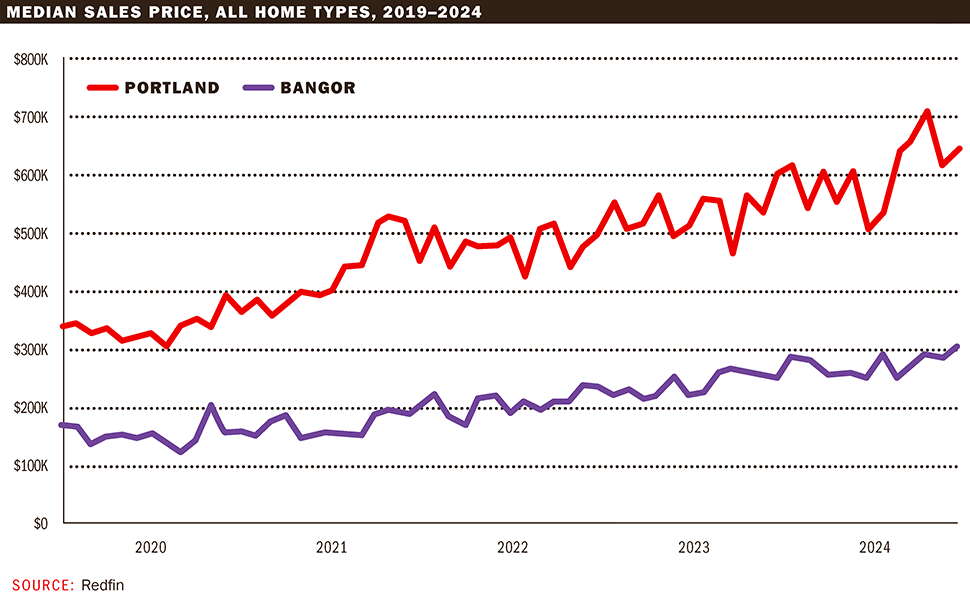
For employers who are already having a tough time finding workers in a tight labor market, the housing crunch makes that task all the more difficult.
At Hollywood Casino Bangor, for example, “there are times that applicants and candidates express concern because they have to use a mailing address for a local shelter as they are in transition to permanent housing,” says Kim Jenkins, the casino-hotel’s human resources director.
“They’re concerned with the stigma attached to being unhoused, and that perhaps we will not consider them for employment. This conversation comes up quite regularly.”
While the company can’t provide actual housing, an “emergency team member” directs new colleagues to area resources and organizations. Job candidates needing public transportation to Bangor can also apply for assistance from the 255-employee company, according to Jenkins.

Housing issues are also top of mind for human resources executives at Northern Light Health, whose home office in Brewer is staffed with 864 employees.
“Housing concerns have come up in conversations with individuals considering relocating to the Bangor area,” says Joanna Morrison, who oversees talent acquisition and career development for the health system.
Though the company does not provide transportation assistance to staff members who commute, “we do our best to help by providing local contacts for real estate and our local chamber of commerce for housing,” Morrison says.
With a workforce that’s 380 strong, Husson University helps applicants and new hires in need of housing on a case-by-case basis, according to Janet Kelle, the university’s chief HR officer.
“In some cases, we will work more closely with an incoming employee if they are coming from particularly far away or have more urgent needs,” she says.
Housing ups and downsides
Alongside a host of private and public development projects, Bangor is doing its part to make good on a promise to turn 2024 into the “year of housing.”
Besides creating a rental registry pilot program to connect tenants and landlords, the city is working with Scarborough’s Gawron Turgeon Dillon Architects to create pre-approved building plans for accessory dwelling units and multifamily buildings, according to Krieg.
While the city does not have a figure for private investment money going toward building housing, Emily Ellis of Berkshire Hathaway HomeServices says she has invested $15 million into the Maine Woods Townhomes development.
“I’m not some big-time developer,” the former professional basketball player says during an interview in the living room of one of the model units, all of which have open-floor plans. “I’ve lived in Bangor my entire adult life and I want what’s good for Bangor.”
Some residents didn’t believe that at first, putting up signs reading “No to Development” and “Who is making Hell 4 Us” with a drawing of Satan’s red face.
While she laughs about it now, Ellis believes that not-in-my-backyard voices may prompt other developers to stay outside of Bangor and look at neighboring towns. That’s putting greater pressure on local organizations including BangorHousing and Penquis to do more; both have senior housing projects in the works.
Senior housing in focus
BangorHousing, a quasi-governmental agency that provides living space for low- to moderate-income households, has a portfolio of 846 affordable and market rate apartments in 11 developments throughout Bangor. The agency also administers the federal Housing Choice Voucher program in Bangor and four surrounding towns.
New properties include Blueberry Ridge, an affordable housing development for residents age 55 and older that opened in October 2023.
Since January, all 32 units have been occupied. The apartments, just under 600 square feet, cost $969 per month to rent, including free Wi-Fi, coin-operated washers and driers, a community room and full-time maintenance staff.
Eligibility to live there requires having an income that does not exceed 60% of the area gross median income — which translates into $39,780 for one person or $45,420 for two people
Two other projects in the works, called Sunridge Senior Housing and Sunridge Senior Housing II, will add another 100 affordable housing units for the same demographic, with construction on the first communities to start this fall and the application on the second due in September.
By adding more senior housing, “it really enables older persons to move into a smaller space and have amenities they wouldn’t have if they owned a home,” says Cindy Witas, BangorHousing’s development director. That, in turn, frees up homes for younger buyers to purchase and rentals for others.
“We really feel like when we house an older person that had previously been a homeowner, it’s allowing three families to move forward,” she notes.
With 567 units of public housing in need of renovations that will have to be done in stages, BangorHousing is in discussions with MaineHousing on how to structure those projects.
The agency is also using $2 million in federal funds to turn its administration building into an Opportunity Center to house the agency’s resident services. The facility will also offer training and education to people who live in public housing, and day care provided by the Boys and Girls Club of Bangor.
By opening educational opportunities for parents, the long-term goal is to help move families out of poverty.
“Providing housing is so much more for us than providing physical space,” Witas underscores. “BangorHousing wants to provide a home that allows people to live their best life.”
Building senior housing is also a priority for Penquis, a Bangor-based nonprofit agency with 40 units under construction on the Milford Street Extension north of downtown.
Known as Milford Place, the complex will consist of a three-story building on nearly two acres of one-bedroom units ranging from 675 to 700 square feet each. Penquis is working on the project with TAC Architectural Group Inc. and Dunbar & Brown Construction, both of which are based in Bangor.
Using the University of Maine’s 3D printing technology, Penquis also intends to construct a whole neighborhood of nine bio-based 3D homes funded with federal money. Penquis plans to submit a site application for the plan in the next few weeks.
Once the agency gets the green light, the homes can be built “in as little as a couple of days,” says Jason Bird, Penquis’s housing development director. “This has a tremendous opportunity to produce housing faster and cheaper that’s still quality and adaptable.”
‘Dance of efficiency’
Back at the Maine Woods Townhomes, dwellings are filling up almost as fast as they’re going up.
“We’ve got the dance of efficiency going right now, where as soon as we’ve got a frame, we’ve got the plumbing and the electric being done,” Ellis reports.
“As soon as they’re done, the insulator comes in,” she says. “As soon as he’s done, we’ve got the sheet rocker in there. As soon as he’s out, we’ve got the painter in there … The efficiency allows you to make it affordable — you’re not waiting three months for the painter to show up.
"We’ve done this for a long while, so we’ve got built-in relationships with really good contractors. When we call, they show up.”
Expecting this development to be her last, she says, “I’ve made my investment in Bangor, and I think Bangor will see the fruits of that investment for many years to come.”
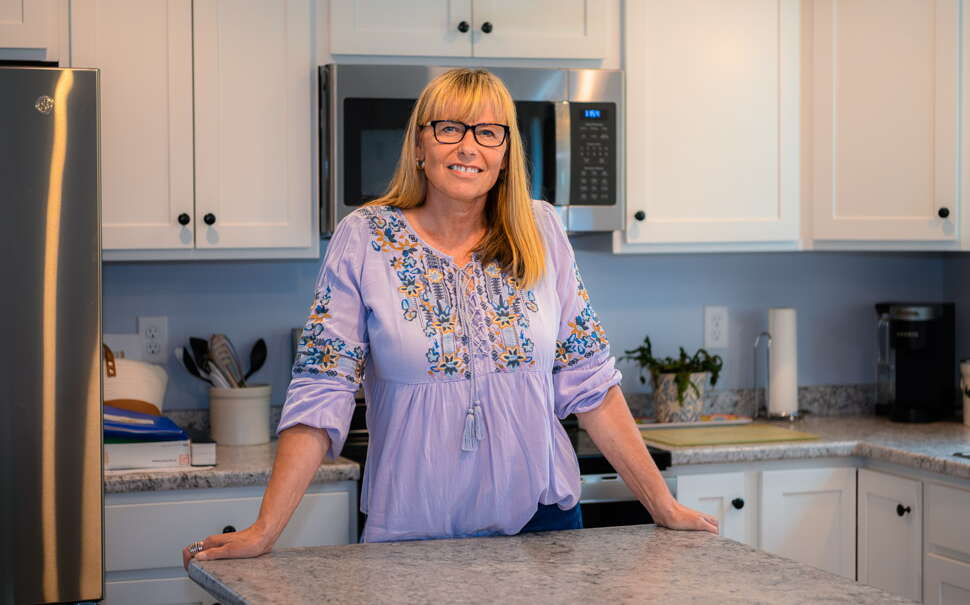
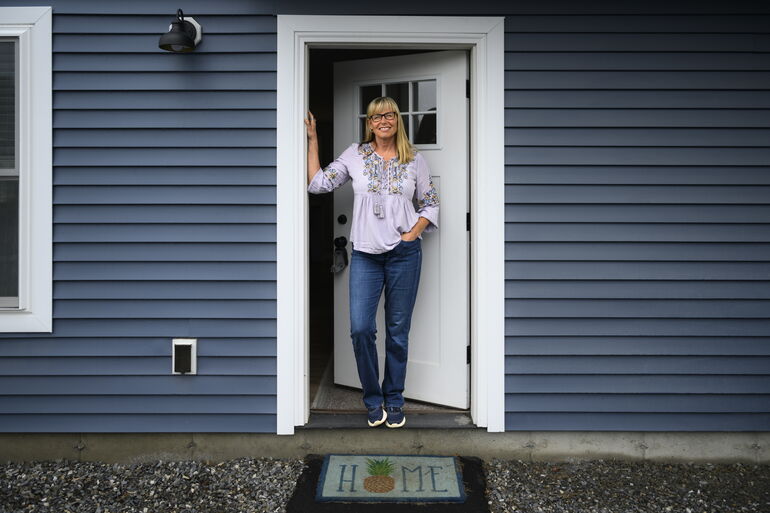
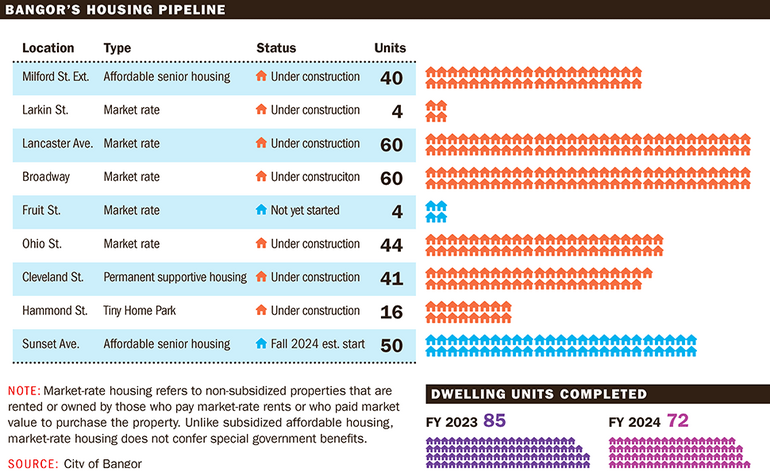














0 Comments